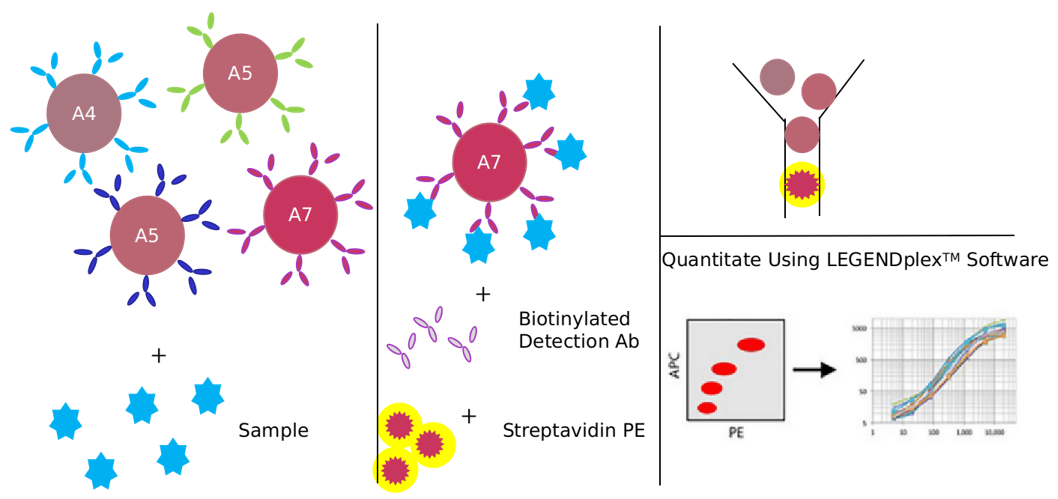Akt signaling pathway
Based on Luminex technology platform, Creative Proteomics provides analysis services for key targets of Akt cell signaling pathway.
AKT, also known as protein kinase B (PKB) or RAS-alpha, is a ubiquitous serine/threonine kinase that plays an important role in a variety of biological reactions such as metabolism, regulation of cell survival and growth. This protein kinase is activated by insulin, PI3K, IGF1 and other growth and survival factors. AKT inhibits cell apoptosis by inhibiting phosphorylation and inactivating multiple targets including forkhead transcription factors and caspase-9, thereby promoting cell survival. The AKT pathway is the main goal of cancer drug discovery research. Invitrogen AKT signaling pathway antibodies are designed to reliably detect key AKT targets. Each antibody has been validated for various applications.
PKB/Akt is divided into PKBa/Akt1, PKBB/Akt2 and PKBy/Akt3 according to the different tissue specificities. The former two are widely found in a variety of tissues, while PKBy/Akt3 has a strict tissue distribution, mainly distributed in In the brain and testicles. The PKB/Akt protein is composed of approximately 480 amino acids, including the amino-terminal PH domain (pleckstrin homology domain), the middle kinase domain and the carboxy-terminal tail.
Akt acts on the TSC1/TSC2 complex and mTOR signaling pathway to regulate cell growth; acts on CDK's inhibitory molecules P21 and P27, and indirectly affects the expression levels of cyclinD1 and p53 to regulate cell cycle and cell proliferation. Akt can promote cell survival by directly inhibiting pro-apoptotic signals such as pro-apoptotic regulators Bad and Forkhead family transcription factors. The transport of T lymphocytes to lymphoid tissues is controlled by the expression of adhesion factors downstream of Akt. Akt can also regulate neuronal function-related proteins such as GABA receptor ataxin-1 and huntingtin molecules. Akt has also been found to bind to Smad molecules to regulate TGFβ signaling. Akt also plays a role in the structural organization of nucleoprotein by phosphorylation of lamin A antigen.
Our detectable targets:
| JAK1 | TSC1 | TSC2 | ATG13 | Gab1 | Gab2 |
| Lyn | Tpi2 | AS160 | PIP5K | GS | MDM2 |
| GSK3 | GSK3 | Wee1 | Myt1 | PFKFB2 | Ataxin-1 |
| eNOS | BcI-2 | PDCD4 | S6K | XIAP | Bim |
| Bax | PTEN | PP2A | PHLPP | CTMP | BCAP |
| IRS-1 | IKK-α | p21 | p70 | SyK | p53 |
| PI3K | p27 |
Technology platform
We provide Luminex technology for Akt cell signaling pathway analysis.
Luminex technology is a multifunctional liquid phase analysis platform developed on the basis of colored microspheres, laser technology, applied fluidics and high-speed digital signal processing technology. The core is to encode polypropylene microspheres or magnetic microspheres with fluorescent dyes. By adjusting the different ratios of the two fluorescent dyes, up to 100 microspheres with different fluorescence spectra can be obtained. Each kind of microspheres is covalently cross-linked. Capture antibodies against specific antigens.
The Akt signaling pathway has a variety of biological activities, and it plays a role in promoting the growth and proliferation of tumor cells, inhibiting apoptosis, promoting invasion and metastasis, regulating tumor angiogenesis and the treatment of resistant tumors.
In addition to Luminex Multiplex Assay, Enzyme-linked immunosorbent assay (ELISA), Flow cytometry (FACS analysis) technology can also be provided to meet other customer needs.
Advantages of Akt cell signaling pathway detection:
- Versatility: VEGF signaling pathway technology can be applied to a variety of biological tests, including immune analysis, genotyping, gene expression, enzyme analysis, etc. It can detect both protein and nucleic acid. In addition to clinical use, it can also be used in scientific research, CDC, blood stations, agricultural, biological and pharmaceutical professional laboratories.
- High-throughput and high-speed: Each microsphere is used as a separate test body, which can perform a large number of biological tests at the same time. It only needs 10~201 samples to test up to 100 indicators at a time, and the fastest can reach 10,000 tests /hour.

Application of our service:
- To study the influence of each virus on Akt cell signaling pathway
- To study the regulatory mechanism of Akt cell signaling pathway in diseases
- To study the effects of drugs or therapies on Akt cell signaling pathway
Creative Proteomics has developed a signal pathway target detection platform. We are not limited to providing Akt cell signal path detection services, but can also provide other signal path detection services. If you want to detect other targets, please contact us and we will customize the service for you. Look forward to working with you.
References:
- Jian-Cheng Xi, Hai-Yu Zang, et al. The PI3K/AKT cell signaling pathway is involved in regulation of osteoporosis. Journal of Receptors and Signal Transduction, 2019, 6(35).
- Testa JR, Bellacosa A. Akt plays a central role in tumorigenesis. Proc Natl Acad Sci USA, 2020, 98(20): 10983-10985.



